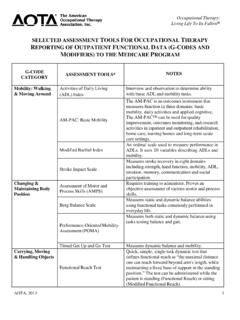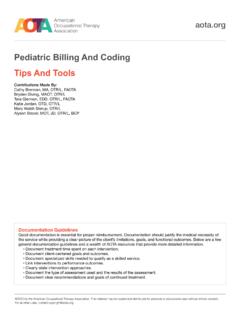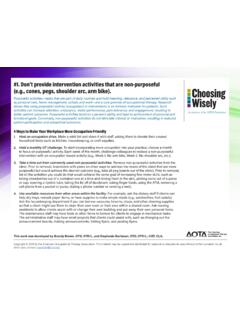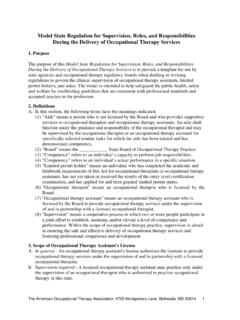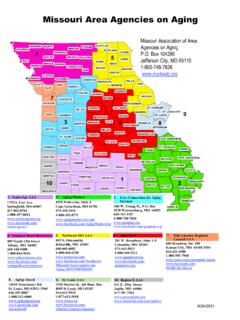Transcription of Aging in Place Safe at Home Checklist - AOTA
1 Rebuilding Together 1899 L Street NW, Suite 1000 Washington, DC 20036 800-473-4229 www. 1. EXTERIOR ENTRANCES AND EXITS Note condition of walk and drive surface; existence of curb cuts Note handrail condition, right and left sides Note light level for driveway, walk, porch Check door threshold height Note ability to use knob, lock, key, mailbox, peephole, and package shelf Do door and window locks work easily? Are the house numbers visible from the street? Are bushes and shrubs trimmed to allow safe access? Is there a working door bell? 2. INTERIOR DOORS, STAIRS, HALLS Note height of door threshold, knob and hinge types; clear width door opening; determine direction that door swings Note presence of floor level changes Note hall width, adequate for walker/wheelchair Determine stair flight run: straight or curved Note stair rails: condition, right and left side Examine stairway light level Note floor surface texture and contrast Note if clutter on stairway 3.
2 BATHROOM Are sink basin and tub faucets, shower control and drain plugs manageable? Are hot water pipes covered? Is mirror height appropriate, sit and stand? Note ability reach shelf above, below sink basin Note ability to step in and out of the bath and shower Can resident use bath bench in tub or shower? Note toilet height; ability to reach paper; flush; come from sit to stand posture Is space available for caregiver to assist? 4. KITCHEN Note overall light level, task lighting Note sink and counter heights Note wall and floor storage shelf heights Are under sink hot water pipes covered? Is there under counter knee space? Is there a nearby surface to rest hot foods on when removed from oven?
3 Note stove condition and control location (rear or front) Is there adequate counter space to safely prepare meals? 5. LIVING, DINING, BEDROOM Chair, sofa, bed heights allow sitting or standing? Do rugs have non-slip pad or rug tape? Chair available with arm rests? Able to turn on light, radio, TV, Place a phone call from bed, chair, and sofa? 6. LAUNDRY Able to hand-wash and hang clothes to dry? Able to safely access washer/dryer? 7. BASEMENT Are the basement stairs stable and well lit? Is there any storage of combustible materials? 8. TELEPHONE AND DOOR Phone jack location near bed, sofa, chair? Able to get phone, dial, hear caller? Able to identify visitors, hear doorbell?
4 Able to reach and empty mailbox? Wears neck/wrist device to obtain emergency help? Is there an answering machine? Is there a wireless phone system? 9. STORAGE SPACE Able to reach closet rods and hooks, open bureau drawers? Is there a light inside the closet? 10. WINDOWS Opening mechanism at 42 inches from floor? Lock accessible, easy to operate? Sill height above floor level? Are storm windows functional? 11. ELECTRIC OUTLETS AND CONTROLS Sufficient outlets? Are there ground fault outlets in kitchen and bathroom? Light switch at the entrance to each room Outlet height, wall locations Low vision/sound warnings available? Extension cord hazard? Are there any uncovered outlets or switches?
5 12. HEAT, LIGHT, VENTILATION, SMOKE, CARBON MONOXIDE, WATER TEMP CONTROL Are there smoke/CO alarms and a fire extinguisher? Are Thermostat displays easily accessible and readable? Note rooms where poor light level exists Able to open windows; slide patio doors? Able to open drapes or curtains? Note last service date for heating/cooling system Observe temperature setting of the water heater COMMENTS: Safe AT HOME Checklist Created in partnership with the Administration on Aging and the american occupational therapy association Rebuilding Together has long recognized that greater attention must be given our elderly population, so they may age-in- Place and safely in their homes.
6 We have also built lasting national partnerships with Area Agencies on Aging , AARP, american occupational therapy association , National association of Home Builders, National Council on Aging , and others. Use this list to identify home safety, fall hazards and accessibility issues for the homeowner and family members. Home safety, fall prevention and accessibility modification interventions on the reverse side of this page can help prioritize your work. Underline or use a highlighter to note. problems and add comments. HELP PREVENT FALL S - SAVE A LIFE 1. EXTERIOR ENTRANCES AND EXITS Increase lighting at entry area Install stair rails on both sides Install door lever handles; double-bolt lock Install beveled, no step, no trip threshold Remove screen or storm door if needed Create surface to Place packages when opening door Install peephole on exterior door Repair holes, uneven joints on walkway Provide non-slip finish to walkway surface Add ramp as needed Trim bushes and shrubs to provide clear view from doors and windows Trim low hanging branches 2.
7 INTERIOR DOORS, HALLS, STAIRS Create clear pathways between rooms Apply color contrast or texture change at top and bottom stair edges Install door lever handle Install swing-clear hinges to widen doorway. Minimum width: 32 inches Install beveled thresholds (max 1/2 inch) Replace or add non-slip surface on steps Repair or install stair handrails on both sides 3. BATHROOM Install swing-clear hinges to widen doorway. Minimum width: 32 inches Install secure grab bars at toilet, bath and shower Install adjustable-height, hand held shower head Install non-slip strips in bath/shower Secure floor bathmat with non-slip, double-sided rug tape Adapt flush handle or install flush sensor Adapt or relocate toilet paper dispenser Round counter corners to provide safety Insulate hot water pipes if exposed Create sitting knee clearance at basin by removing vanity door and shelves underneath Install mirror for sitting or standing view Install good-quality non-glare lighting Install shower with no threshold if bathing abilities are severely limited Elevate toilet height by adding under seat riser, portable seat.
8 Or raising toilet at the base 4. KITCHEN Increase task lighting at sink, stove, etc. Install D-type cupboard door handles Install adjustable shelving to increase access to upper cabinets Increase access to under counter storage space by installing pull-out units Insulate hot water pipes if exposed Install hot-proof surface near oven Install switches and outlets at front of counter Install pressure-balanced, temperature-regulated, lever faucets Expand counter surface Create sitting knee clearance under work sites by removing doors or shelves Improve color contrast of cabinet and counters surface edges for those with low vision Add tactile and color-contrasted controls for those with low vision Provide sturdy step stool with hand rail Clean or install new range hood 5.
9 LIVING, DINING, BEDROOM Widen or clear pathways within each room by rear- ranging furniture Secure throw and area rug edges with double-sided tape Improve access to and from chairs and beds by inserting risers under furniture legs Use side bed rail or chairs with armrests Enlarge lamp switch or install touch-control lamp at bedside Install adjustable closet rods, shelving, and light source for better storage access Install vertical pole adjacent to chair and sofa Raise furniture to appropriate height using leg extender products Install uniform level floor surfaces using wood, tile, or low-pile rugs Install telephone jack near bed and favorite chair 6. LAUNDRY Build a counter for sorting and folding clothes Adjust clothesline to convenient height Relocate laundry appliances Clean dryer vent or replace with metallic hose 7.
10 BASEMENT Identify and eliminate sources of water in basement (usually gutters our plumbing) Add additional lighting as needed Remove combustible materials and hazardous waste Clear pathway to utilities 8. TELEPHONE AND DOOR Install wireless phone system near bed, sofa, and chair Install peephole at convenient height Install flashing light or sound amplifier to indicate ringing doorbell for those with visual or hearing problems Install mailbox at accessible height 9. STORAGE SPACE Install lights inside closet Install adjustable closet rods and shelves Install bi-fold or pocket doors 10. WINDOWS Install handles and locks that are easy to grip, placed at appropriate heights Replace windows or storms that are not functional 11.




